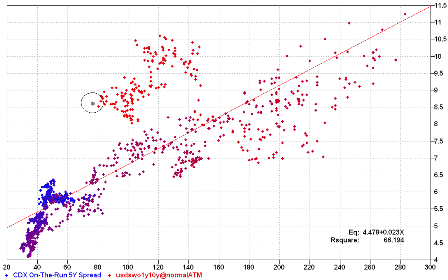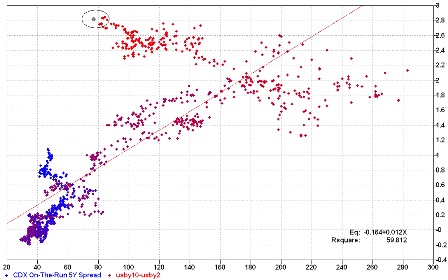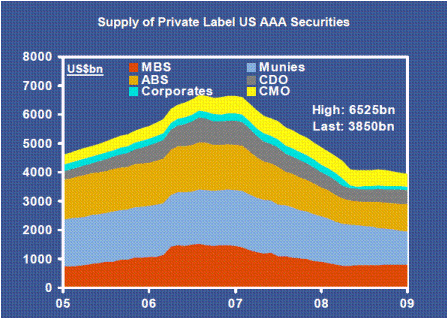>
> —– Original Message —–
> From: Hadden, Glenn (FID)
> Sent: Monday, April 18, 2011 04:45 PM
> Subject: IMPORTANT – thoughts on S+P action re USA
>
I would like to address the action taken today by S+P in revising the United
States credit outlook to negative.
Simply, I believe the argument behind S+P’s decision is flawed and displays
a misunderstanding of how the monetary system operates. My view is not
predicated on any political ideology. I am merely attempting to demonstrate
the incorrect logic regarding United States credit quality and solvency.
1. FINANCIAL BALANCE FRAMEWORK:
The first fundamental item that must be understood is how financial balances
relate to government indebtedness. In a closed economy (or an economy with a
perpetually balanced current account), government deficits must equal
private savings. If private savings desires increase, a government’s deficit
must increase by precisely the same amount all things equal. There is no
other way.
In the case of the United States, the budget deficit has grown to 10% of gdp
from approximately 4% of gdp because the savings rate has shifted from
approximately negative 2% to approximately positive 6%. Simply stated, the
federal budget isn’t a function of profligate government spending, its a
function of higher desired private savings causing a shortage of aggregate
demand. This shortage of aggregate demand is putting downward pressure on
tax revenues (lower nominal gdp implies lower tax revenues) and upward
pressures on expenditures owing to automatic stabilizers such as UI.
With this example, it is theoretically possible to have much larger
government deficit and debt levels if savings desires grow commensurately.
If private sector savings desires were to fall, which implies higher
aggregate demand (because the spending of a person in the private sector
simply creates another person’s income), the government deficit would fall
commensurately owing to higher tax revenues and possibly lower expenditures.
2. MYTHS REGARDING FOREIGN INVESTORS FUNDING THE UNITED STATES AND EXTERNAL LIABILITIES:
Firstly, the most important item to understand is the USA discharges its
debt in $US. So the entire argument of rating agencies behind ‘external
funding pressures’ is moot. Functionally there is no difference between a
holder of UST’s who is domiciled in USA or abroad, as they are both $US
dominated savers. The only difference is the foreign saver has no ‘need’ to
save in $US (where a USA investors needs $US as a means of exchange and to
pay his taxes).
So, what if foreign now dump their ust’s?
Foreign investors own ust’s and $us because they WANT to own them. By
engaging in fx driven trade policies, foreigners ‘pay up’ to get $US which
allows them greater sales into the USA market. If foreigners didn’t want to
save in $US, they would change their fx policy which would result in less
market share in USA economy. Foreigners can’t be both buyers and sellers
simultaneously. If foreigners wanted to own less $US, the result would be a
smaller current account deficit in USA, which again using a financial
balance framework would either result in more private savings, or a smaller
govt deficit. Bottom line – if foreigners want to have fewer savings in $US,
either private savers must increase savings, or the govt deficit must fall.
3. MYTHS REGARDING FOREIGN INVESTORS FUNDING THE UNITED STATES AND EXTERNAL LIABILITIES part II:
The same way banks offer savers demand deposits and term deposits (ie
chequing accounts versus savings accounts) the USA economy offers savers the
same in the form of $US (demand assets) or UST (term asset). Foreign savers
can therefore keep their $ at their Fed Reserve account and earn basically
zero (functionally a ‘chequing’ or demand account) or buy UST’s
(functionally a ‘savings’ or term account) and earn a coupon. There is no
other way to save in risk free space. As said above, foreigners who engage
in fx driven trade policies must accumulate $US demoninated assets. The only
choice they have is term vs demand assets. So indeed if foreigners declined
to own ust’s and alternatively kept their savings in $US at the Fed, the
result could be a higher and steeper term structure for USA rates. If the
Treasury decided to sell less ust’s and more tbills, this term structure
rise could be negated. Note foreigners actions are never about SOLVENCY, its
merely a function of liquidity preference.
4. THE DEFAULT BY THE SOVEREIGN OPERATING WITHIN A NON-CONVERTABLE EXCHANGE RATE REGIME IS A *FUNCTIONAL* IMPOSSIBILITY:
One must also understand the mechanics of government spending. A government
purchases goods and services from the private sector and then the Federal
Reserve credits the reserve accounts of the commercial banks whom the
sellers of such good and services bank. The Fed then debits the reserve
account of The US Treasury. The Treasury then sells ust’s, where the Fed
then credits the Treasury’s reserve account while debiting the reserve
accounts of the banking system.
So all that has happened is the government has created savings in the
economy by spending (from point 1 above: govt spending = private savings).
So as is illustrated, there is no issue of ‘solvency’ per se. The
government, by spending, is creating the savings to buy the ust’s. The only
issue here is the term gap. Specifically if savers only want demand assets
(ie $us), while the Treasury only wants to sell term assets (ie ust’s), the
resolution will be price and risk premium: ie how much interest rate spread
will a bank or arbitrageur need to intermediate this imbalance. This can all
be negated of course, if the Treasury only issued T-bills.
5. THE DEFAULT BY THE SOVEREIGN OPERATING WITHIN A NON-CONVERTABLE EXCHANGE RATE REGIME IS A *FUNCTIONAL* IMPOSSIBILITY part II:
This is the fundamental flaw of the S+P decision. The basis of their
sovereign rating criteria is as they describe it is: “The capacity and
willingness to pay its debts on time”. As mentioned above, there is
functionally no reason for the USA to ever not pay its debts – the USA’s
debts are and will always be equal to savings desires of the private and
foreign sectors. So ‘CAPACITY’ can never be an issue.
Hence the only reason the USA would ever default was because they ‘wanted’
to default, they never under any circumstance NEED to default so long as the
$US remains a non-convertable currency. The implications for a voluntary
default (again, this is the only kind of default possible by the USA) make
such a default an impossibility. The reason is because the 2nd largest
liability of the federal government is deposit insurance. If the USA decided
it wanted to default to escape its obligations, it would bankrupt its
banking system, who’s holdings of ust’s are greater than system-wide bank
capital of $1.4 Trillion. In fact the contingent liability put the
government has issue via deposit insurance is almost as large as USA debt
held by the public at $6.2 Trillion. So essentially a voluntary default
would actually INCREASE USA indebtedness by almost 100% while
simultaneouslybankrupting its banking system. So if ABILITY to pay is
assured, and a voluntary default actually raises indebtedness while
collapsing the banking system and economy, why would USA ever voluntarily
default? So S+P’s criteria of ‘WILLINGNESS’ to pay is also not applicable.
SUMMARY:
So as demonstrated, the bottom line is ABILITY to pay can never be an issue
in a non-convertable currency system. The only issue is WILLINGNESS to pay.
So if the argument by S+P relates to “the capacity and willingness to pay
its debts on time” as they described on Monday’s call, then their argument
simply isn’t cogent.
The last point I want to make is it would be incorrect to attempt to draw an
analogy to the placement of the UK on credit watch in mid May 2009 relating
to market performance. Yes indeed gilts sold off shortly after this
announcement. However this was more a function of the unhinging of the USA
MBS market. There existed a perception that the Fed via QE1 was attempting
to cap current coupon mortgage rates at 4%. Once this level was breached and
it became clear in mid/late May that this view was incorrect, a convexity
sell event hit the USA rates market which dragged all global bond yields
higher including Gilts.
To conclude – I view the decision today by S+P as having zero impact on
valuations of USA sovereign debt. We continue to engage in trades that
express the correct view that the solvency of the United States can never be
an issue in nominal terms; specifically we are buyers of 30yr assets swaps
at -25bps.




